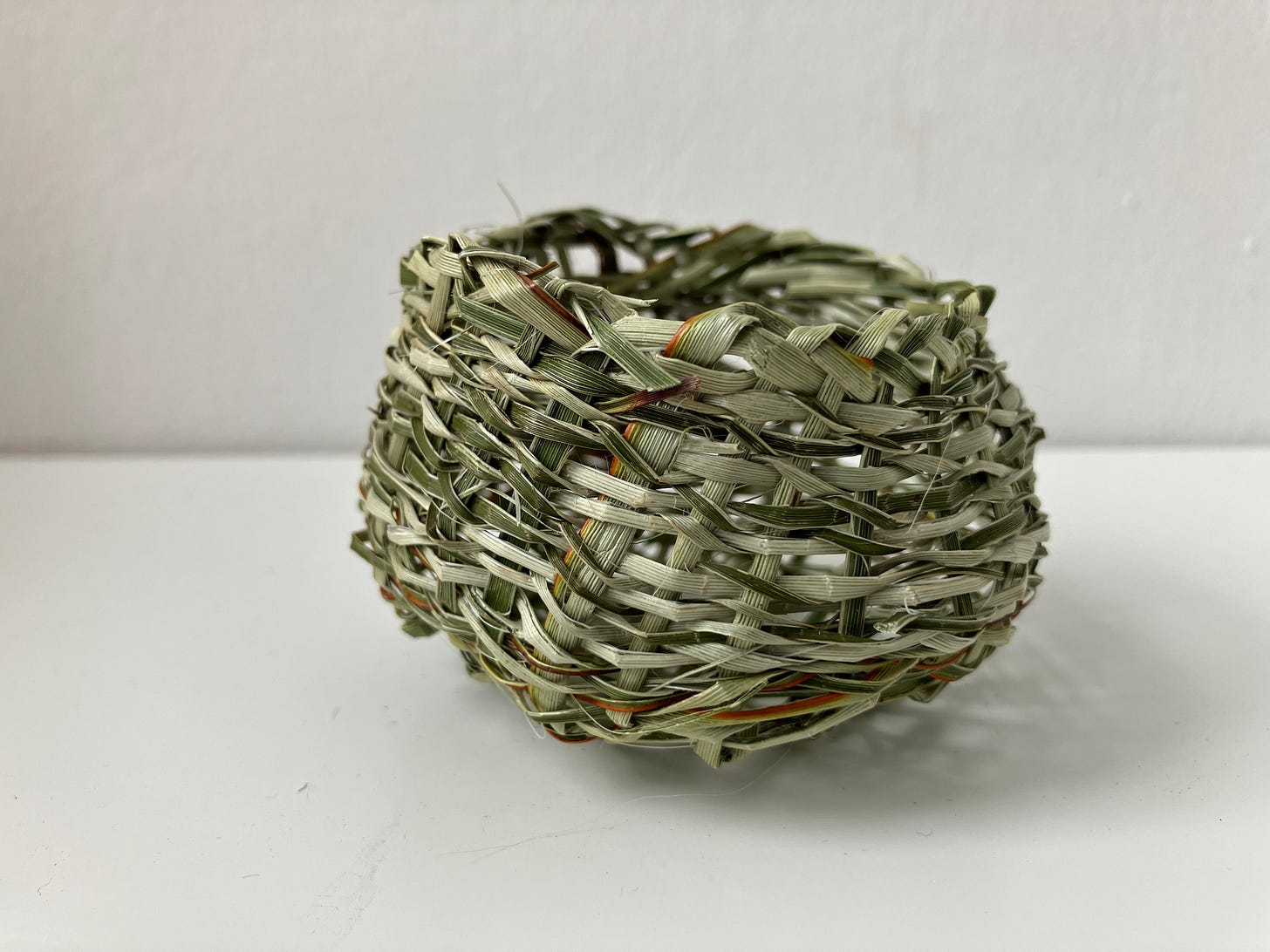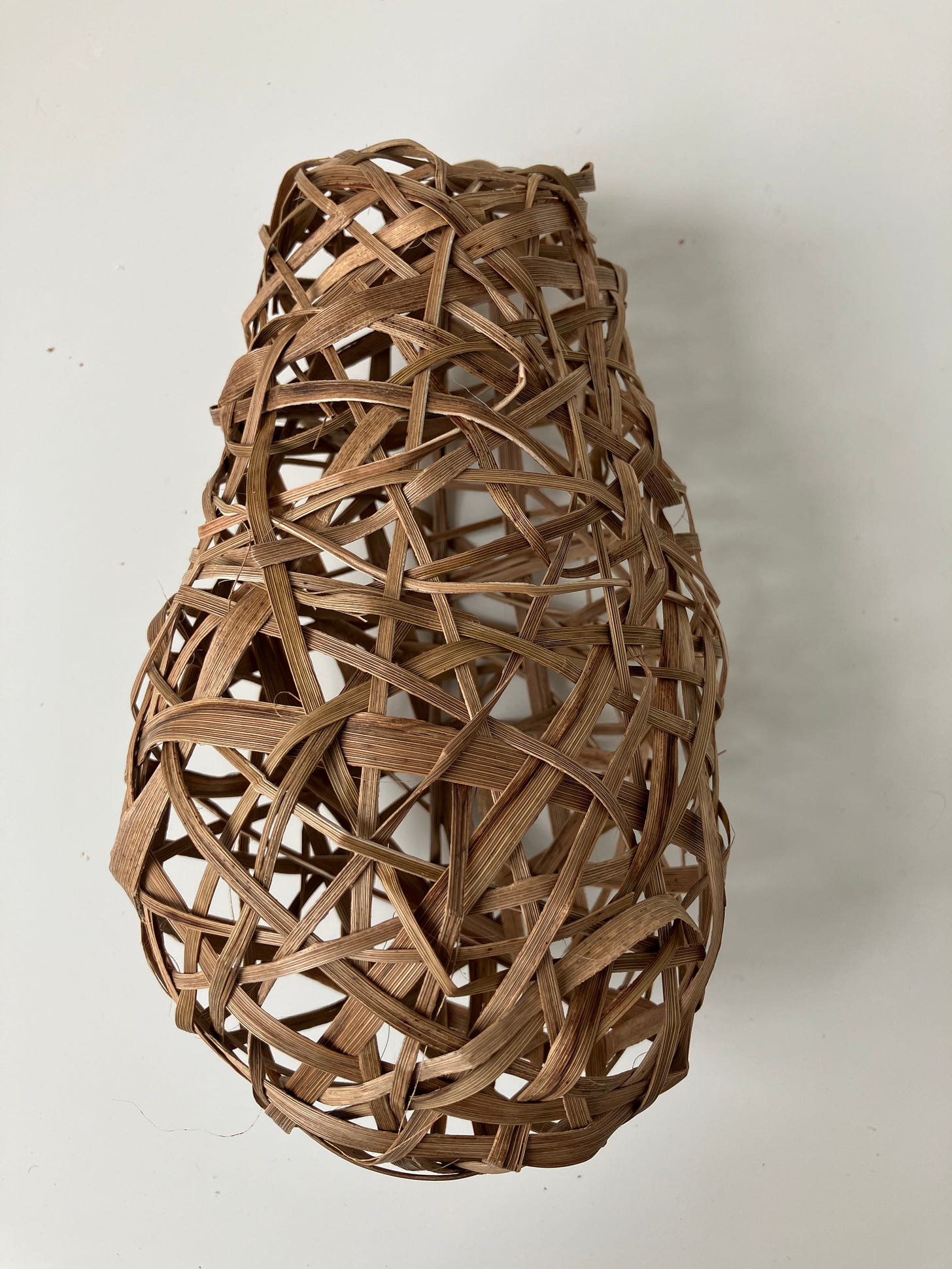I Begin with Containers
Weaving Research
Hi and Welcome to A Nomadic Rose! If you’ve found your way here but are not yet subscribed, you can do so HERE. You will never miss a letter, and I’ll be eternally grateful for your support.
Now on to this week’s musings…
A few weeks ago I presented at the PhD Summer Symposium. The symposium marked the (sort of) completion of the first year of my PhD. Two full days spent among my fellow researchers learning about their work. It was fascinating, personal, and surprisingly emotional. I shared a little of what I have been working on recently, bringing woven wild fibres into the room, along with a few contextualising thoughts. I wanted to share them with you as well…
My hands yearn to contribute. After the sterility of text and type, page and keyboard, I need touch and texture. Haptic expression and exploration. An embodied beginning to my research. But I freeze before I can begin, challenged by new layers of understanding that won’t allow me to reach blindly for the art forms I once relied upon. Instead, as I set out to create art that centres the loss of a 6th mass extinction, I seek materials that will sit lightly upon the world. Materials I can bear the cost of. Materials sourced beyond the shelves of the art shop. The foraged and the local, the waste and the byproduct. I seek eco-materiality, though I only find the word once my search has begun.
In Braiding Sweetgrass Robin Wall Kimmer presents the idea of The Honorable Harvest, which though not traditionally written down Kimmer suggests might read as follows:
‘Know the ways of the ones who take care of you, so that you may take care of them.
Introduce yourself. Be accountable as the one who comes asking for life.
Ask permission before taking. Abide by the answer.
Never take the first. Never take the last.
Take only what you need.
Take only that which is given.
Never take more than half. Leave some for others.
Harvest in a way that minimizes harm.
Use it respectfully. Never waste what you have taken.
Share.
Give thanks for what you have been given.
Give a gift, in reciprocity for what you have taken.
Sustain the ones who sustain you and the earth will last forever.’
(Kimmerer 2013:183)
These guiding principles provide a framework for my eco-materiality, one that acknowledges the loss of more-than-human life no matter what is being harvested or for what purpose. Kimmer writes of the challenges in applying The Honorable Harvest when shopping, admitting that she struggles to conjure the more-than-human when faced with packaged paper and pens. Thinking of the materials I have traditionally used - camera film, bronze, recycled plastic - I too struggle to visualise the lives lost during production. I am too far removed, separated from the more-than-human even in the act of making ecological art. That separation sits at the heart of the earth crisis. We have built the very concept of civilisation on the erroneous belief that we stand apart from all other life on this planet. This anthropocentrism is used to justify a dishonourable harvest, one that treats the more-than-human as a resource and has brought us to the brink of mass extinction. To undertake my research ethically and with integrity I feel compelled to directly face the lives and deaths of the more-than-human, not only as my subject but as part of, and a result of, what I create. And so, I seek new materials, ones that do not disguise or hide the cost of my research.
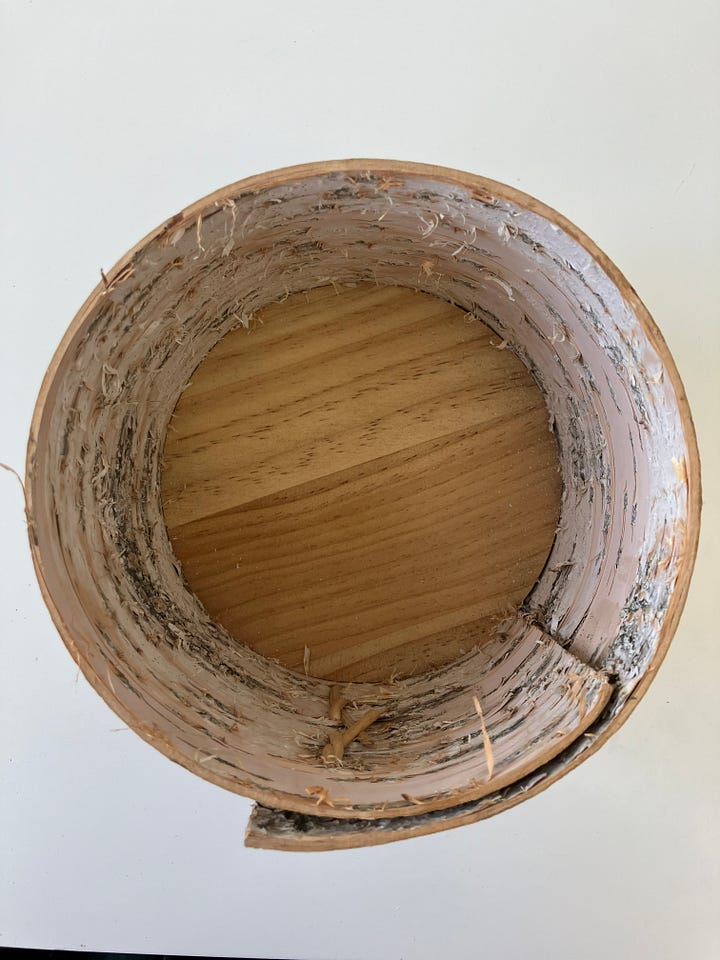

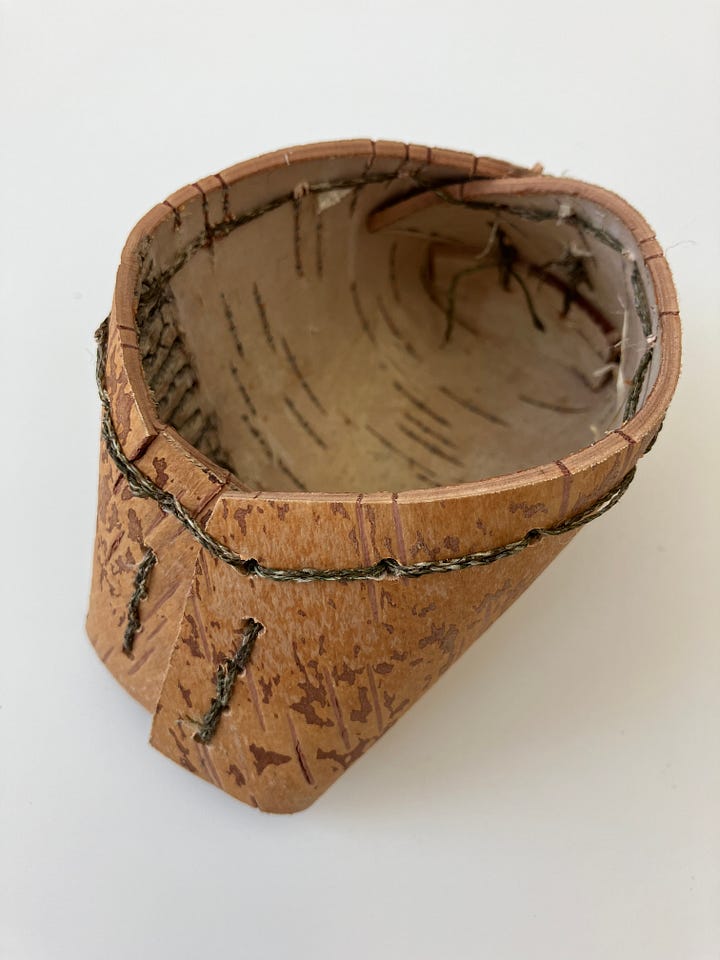
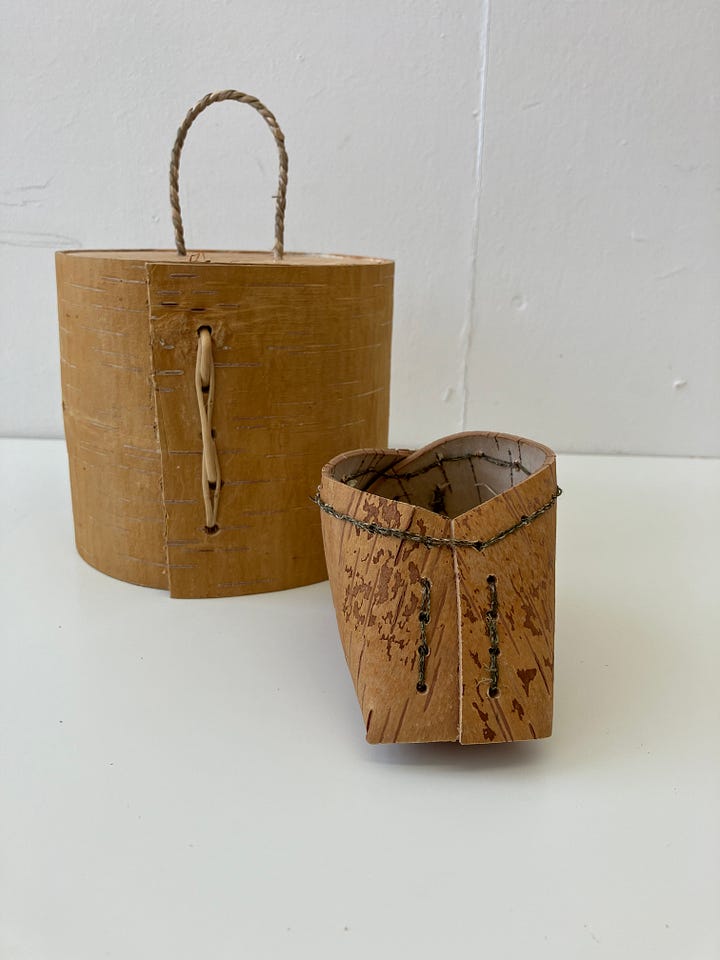
These materials start to fill my studio. Nettle. Willow. Birch Bark. Deer Skin. Fibres and sinews and bones. Their potential only just beginning to be unlocked. Seeking a way to learn, my yearning hands need shape and form. But I do not want to waste these more-than-human lives on forms without meaning. Reading Ursula K. Le Guin’s The Carrier Bag Theory of Fiction I find my answer. Le Guin writes of the hero narrative, the killer story, which has coopted all other narratives. This is the story upon which destructive anthropocentrism has been built. Proposing the need for a different story, ‘the life story’ (Le Guin 2019: 33), Le Guin suggests ‘the bottle as hero… bottle in its older sense of containers in general, a thing that holds something else… A leaf a gourd a shell a net a bag a sling a sack a bottle a pot a box a container. A holder. A recipient.’ (Le Guin 2019: 28-29) This is the form my hands need, the form through which I can begin to learn my new materials: the container. Perhaps humanities oldest object, it is the perfect encapsulation of the reciprocity that sits at the heart of The Honorable Harvest. This is where I will begin.
Working in the studio, I find myself drawing parallels between the container I am forming and the concept of the museum- a word whose presence in my research title is challenging and ripe with potential. Museums and galleries are vast containers, each filled with smaller containers - frames and plinths and glass fronted display cases. Since their early history museums have been instrumental in constructing and furthering the colonial, patriarchal narratives that have led to the earth crisis: the myth of civilisation, the killer story. However, as containers they also hold the potential for the other story, the life story.
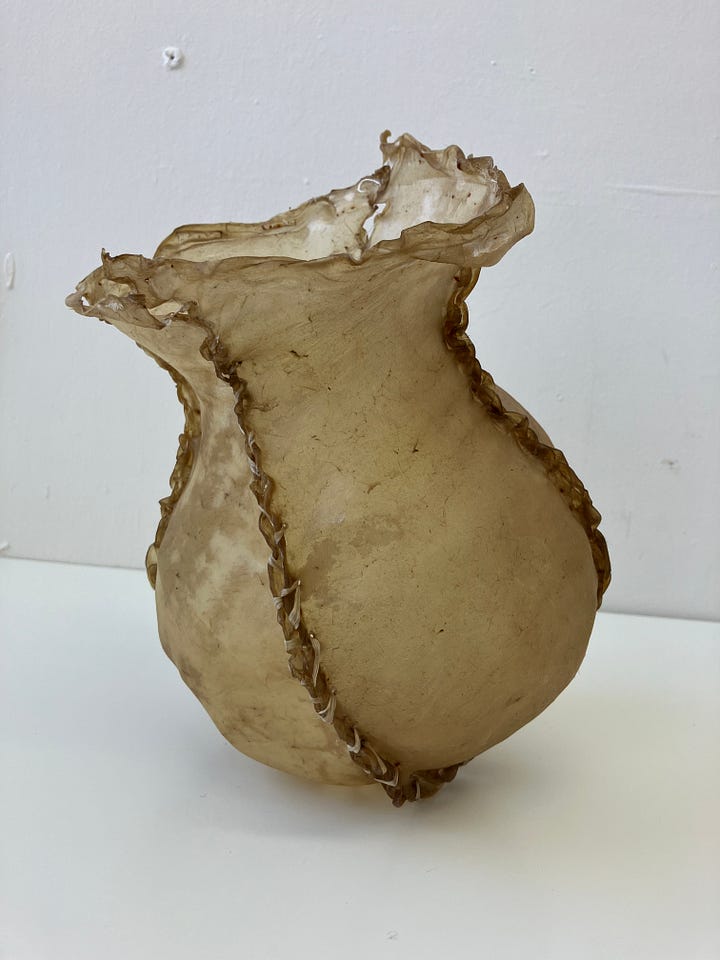
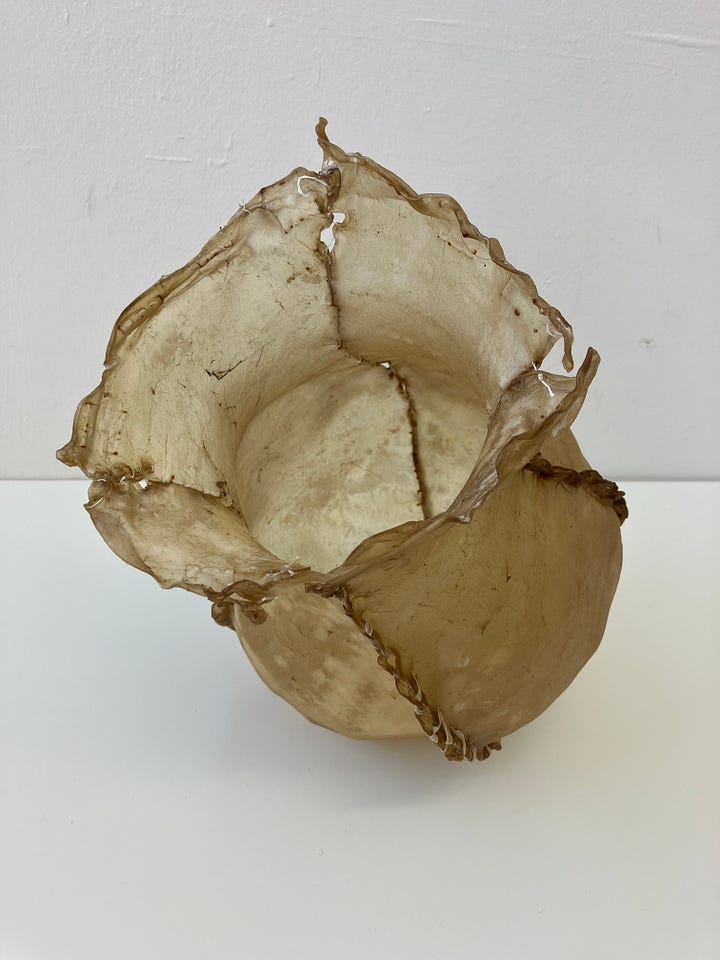
In her essay The Frames of Specimens: Glass Cases in Bergen Museum Around 1900, Brita Brenna explores the role of glass in transforming museum displays and framing ‘“museum nature”… a term for what the museum produces: a very specific kind of nature...’ (Brenna 2013: 37). The introduction of the glass display case, an icon of museum containers, led to a standardisation of museum display’s that is still used today. Reading the essay I am caught by Brenna’s comments on the development of the display label at Bergen Museum, London’s Natural History Museum, and others, specifically the idea that, ‘The glass case is like an illustrated book where the text carries the intended meaning and the objects illustrate.’ (Brenna 2013: 48) This idea is as familiar from a lifetime spent visiting museums and galleries as it is from a career in the arts, where the relationship between text and image/object holds the upmost importance.
As a society, we have become fluent in this particular museum language, often reading it unquestioningly and uncritically. However, as museums slowly shift in the face of decolonisation and the earth crisis, this museum language could present an opportunity. As an artist working with the concept of the museum am I able to borrow, upend, and disrupt thanks to our shared tongue? Rather than adhering to this long held standard in which the more-than-human is reduced to illustrative museum object, might the language of the museum as container tell a different story?
My collection of containers grows beneath my hands. I line them up on the windowsill in my studio. Looking at them I wonder what I am creating the containers to carry? What will they hold as my research continues? And I wonder what the museum display label would read…
Birch Bark and Spruce Root Pot.
Stitched to hold my grief.
New Zealand Flax Basket
Woven to gather my courage.
Deer Skin Container
Sculpted to reshape my fear.
BRENNA, Brita. 2013. ‘The Frames of Specimens: Glass Cases in Bergen Museum Around 1900’. In Liv Emma THORSEN, Karen A. RADER, and Adam DODD (eds.). Animals on Display: The Creaturely in Museums, Zoos, and Natural History. University Park, Pennsylvania: Pennsylvania State University Press.
KIMMERER, Robin. 2013. ‘Braiding Sweetgrass’. United States: Milkweed Editions.
LE GUIN, Ursula K. 2019. The Carrier Bag Theory of Fiction. Ignota.


